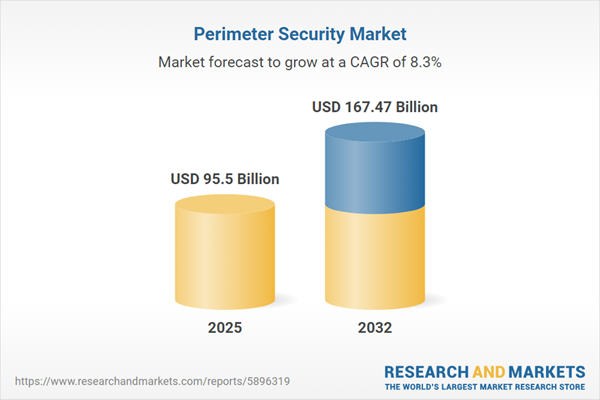Speak directly to the analyst to clarify any post sales queries you may have.
The perimeter security market is undergoing a significant transformation as organizations pursue integrated approaches to protect assets in today’s evolving threat landscape. Senior leaders are adopting comprehensive security strategies that align operational resilience with new risk demands and regulatory standards.
Market Snapshot: Perimeter Security Market Growth Insights
With a robust compound annual growth rate and expanding market size, the perimeter security market is attracting heightened attention from security executives. The shift toward advanced perimeter security solutions stems from the continuous evolution of threat vectors, requiring fast adaptation and strict regulatory compliance. As risk environments become multilayered and complex, organizations are investing in efficient, multi-faceted systems that can manage physical and digital challenges cohesively. Procurement and deployment practices are evolving—security leaders now prioritize integrated technologies that reinforce operational resilience to ensure uninterrupted business activities.
Scope & Segmentation: Strategic Coverage for Senior Decision-Makers
This report provides senior decision-makers with a detailed roadmap to enhance perimeter security strategies while tracking regulatory shifts and adapting to diverse risk scenarios. The analysis covers the following essential segments and regional trends to optimize investment and deployment planning:
- Product Types: Biometric access controls, card readers, and mobile authentication tools address secure facility entry. Fencing solutions—including mesh, palisade, and welded options—offer flexible, site-specific perimeter defense. Sensor systems such as infrared, microwave, radar, and vibration models elevate intrusion detection accuracy. Advanced lighting technologies using halogen and LED ensure optimal visibility for critical areas. Camera solutions, including analog, IP, and thermal models, support comprehensive monitoring and verification capabilities.
- End User Industries: Commercial sectors in finance, telecommunications, and retail seek adaptive security and adherence to regulatory demands. Public sector organizations—government, defense, transportation, and education—require scalable integration to protect wide-ranging assets. Industrial and residential stakeholders demand tailored solutions for their unique risk and operational profiles.
- Component Categories: Essential hardware ranges from versatile sensors to intelligent controllers and diverse camera systems. Software provides advanced analytics and access management. Services include consulting, deployment, and ongoing system support for sustained value.
- Deployment Models: Cloud-based models—hybrid, private, or public—and on-premises options are adopted based on operational needs and security risk assessments.
- Distribution Channels: Organizations access the market via direct sales, value-added resellers, distribution partners, or systems integrators, enabling flexible procurement strategies to match project requirements.
- Regions Covered: North America emphasizes governance and compliance outcomes. The Asia-Pacific region is marked by rapid modernization and deployment cycles. EMEA presents a landscape of diverse regulations and unique operational conditions.
- Leading Companies: Market leadership is maintained by providers such as Johnson Controls International, Honeywell International, Robert Bosch, Siemens, Schneider Electric, ASSA ABLOY, Hikvision, Dahua Technology, Axis, and Motorola Solutions, each delivering adaptive platforms for flexible deployment.
Key Takeaways: Strategic Insights for Executive Decision-Makers
- AI-driven detection paired with cloud-managed technologies prompts real-time threat assessment, facilitating accelerated organizational response and situational clarity.
- Embedding regulatory compliance in procurement workflows elevates baseline security standards during initial planning and operational phases.
- Unified security platforms combining cutting-edge hardware, dynamic analytics, and consultative services streamline adaptation to emerging threats and business growth.
- Regional investment priorities are influenced by demands for urban infrastructure upgrades, transportation modernization, and protection of essential assets.
- The move to subscription-based offerings fosters more agile perimeter security budgeting and aligns spending with shifting business objectives.
- Innovative biometric tools and cloud-based surveillance systems allow more responsive and adaptive controls across physical and digital domains.
Tariff Impact: Regulatory and Supply Chain Adaptation
Adjustments to tariffs in the United States are impacting the cost of sourcing perimeter security hardware. As a direct response, organizations are pursuing supplier diversification and increasing reliance on local sourcing to strengthen supply chain flexibility and mitigate exposure to sudden regulatory shifts.
Methodology & Data Sources
The report’s findings are supported by direct executive interviews and targeted end-user surveys. Analysis is further validated using regulatory documents, respected industry publications, proprietary market research, and shipment records. This approach ensures the reliability of insights for strategic decision-making by executive stakeholders.
Why This Perimeter Security Market Report Matters
- Enables executives to align perimeter security frameworks with evolving regulations and shifting risk environments, promoting organizational resilience and proactive risk management.
- Delivers actionable intelligence on regulatory adaptation and technological change, supporting competitive positioning in a dynamic market landscape.
- Equips organizations with data-driven insights for agile procurement and focused investment, helping enterprises prepare for emerging compliance needs and geopolitical risks.
Conclusion
This report provides senior leaders with actionable strategies to maximize perimeter security investments and improve organizational coordination, ensuring preparedness amid current and emerging security challenges.
Additional Product Information:
- Purchase of this report includes 1 year online access with quarterly updates.
- This report can be updated on request. Please contact our Customer Experience team using the Ask a Question widget on our website.
Table of Contents
3. Executive Summary
4. Market Overview
7. Cumulative Impact of Artificial Intelligence 2025
Companies Mentioned
The companies profiled in this Perimeter Security market report include:- Johnson Controls International plc
- Honeywell International Inc.
- Robert Bosch GmbH
- Schneider Electric SE
- Siemens Aktiengesellschaft
- ASSA ABLOY AB
- Hangzhou Hikvision Digital Technology Co., Ltd.
- Zhejiang Dahua Technology Co., Ltd.
- Axis AB
- Motorola Solutions, Inc.
Table Information
| Report Attribute | Details |
|---|---|
| No. of Pages | 182 |
| Published | October 2025 |
| Forecast Period | 2025 - 2032 |
| Estimated Market Value ( USD | $ 95.5 Billion |
| Forecasted Market Value ( USD | $ 167.47 Billion |
| Compound Annual Growth Rate | 8.3% |
| Regions Covered | Global |
| No. of Companies Mentioned | 11 |









